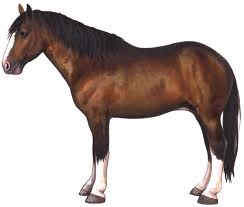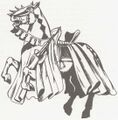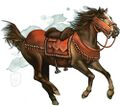Horse: Difference between revisions
1d4chan>The Forgefather No edit summary |
m (77 revisions imported) |
||
| (47 intermediate revisions by 21 users not shown) | |||
| Line 1: | Line 1: | ||
[[image:destrier.jpg|thumb|300px|right|A Destrier Horse]]'''Horses''' (''Equus ferus caballus'') are a subspecies of odd toes ungulates native to the continent of Eurasia on planet [[Earth]]. Horses are quadrupedal herd dwelling herbivorous (specifically grazing) creatures that usually weigh between 250 and 1000 kilograms and are well adapted to long distance running. Starting around 4,000 BCE, horses were domesticated by [[human]]s, first for food, but eventually their primary use was as beasts of burden and in particular as mounts to carry humans about. | |||
[[image:destrier.jpg|thumb|300px|right|A Destrier Horse]] | |||
== History == | |||
Like dogs, horse have been bred by humans into a wide variety of breeds for specialized purposes in different areas. Some are meant for racing, others are meant to carry large loads, and others are intended to carry people (including soldiers). | |||
An extensive list of horse breeds can be found [[wikipedia:List of horse breeds|here]]. | |||
More than any other non human animal (except maybe dogs) the horse has been a direct aide to humans at war as a beast of burden, draft animal and as a mount. While they can travel quickly over short distances, most horses which move faster than an infantryman tire if they are forced to march for too long, which can be lethal for them. As persistence hunters, humans have greater endurance than horses over extremely long distances; this is how horses were domesticated in the first place, by simply following them at a walking pace for hours until they were too tired to resist having a rope tied to them. For horse travel to be significantly faster than walking, they need to be supported by a network of stables so the horses can be used in relay. | |||
At first, they were mainly used to pull chariots: small, lightly built carriages which could carry one or more guys into battle. Usually this would be a driver who had the reigns and either an [[Bows and Arrows|archer]] or a guy with a spear. They were fast, but expensive to produce. Two major changes shifted chariots to Cavaliers. First, horse breeding produces larger animals, such that a team of horses and a set of wheels were no longer needed to carry a rider forward. Secondly, the stirrup was brought over to Europe. Priorly, difficulties with riding a horse on its own made chariots the only reliable way to use horses in battle. | |||
When the stirrup did reach Europe, the chariot fell out of use in favor of mounted warriors such as knights. A combination of heavy armor, mobility, and devastating charges made knights on horseback dangerous foes. Even after the advent of firearms mounted soldiers were valued for their ability to outflank foes; in one famous incident during the Civil War, General Stuart's cavalry rode 126 miles in 60 hours, [[Internet Troll|circumnavigating the Union army]]. Cavalry of all types remained a major part of military units worldwide until the end of World War I, and served in a logistical role until ww2. Even today, horses still see some use by modern militaries as they're the only way to bring more than a man can carry through mountainous terrain. | |||
== In Traditional Games == | == In Traditional Games == | ||
Role-playing games set in the typical vaguely-medieval-European setting will invariably have horses (or some other setting-appropriate mount, like giant lizards or camels) available to speed up travel and increase load capacity between locations. Certain [[classes]], like [[knights]], may have skills to use their horse in combat for increased speed and attack power. Caring for a horse is extremely complicated, to the point that real-world knights and horse-owning nobles had servants specifically tasked with managing the horse; they need to be fed, groomed, and fitted with equipment like horseshoes, saddles, and reins to operate at peak efficiency, and they are not as adaptable to terrain or as capable of sustaining a heavy pace as a [[human]]. Most role-players are more interested in crawling through dungeons than playing "Horse Stable Manager 1500", so the needs and capabilities of horses are usually kept well abstracted. | |||
The novel ''Romance of the Three Kingdoms'' said the historical horse Red Hare was able to travel at least 200 miles in a day (25 MPH with an 8 hour march, 8.33 MPH for a tireless 24 hour march). Even in history it was said to be an exceptional horse. When it shows up in /tg/, it tends to be depicted as being as badass as a horse with (mostly?) horse level intelligence can be. | |||
There is also ample precedent for fiendish horses as ridden by another monster such as [[Dullahan]] and the [[Four Horsemen]]. | |||
===Gallery=== | |||
<gallery> | |||
horse MC1.jpg|2e | |||
horse MM 2e.png | |||
horse 4e.jpg|4e | |||
horse 5e.jpg|5e | |||
horse B1.png|Pathinder | |||
</gallery> | |||
==In Warhammer 40,000== | |||
In 40k nobody can be bothered to use a horse, except the [[Attilan Rough Riders]] and [[Krieg]]ers. This is probably because [[White Scars|bikes]], [[Eldar|Jetbikes]], or [[Catachan|even giant xeno-lizards]] are better. Despite this, horses are eaten by the forces of the Imperial Guard. | |||
<gallery> | |||
mounted regiments.webp | |||
IG5ERoughrider.jpg | |||
death rider 3.webp | |||
death rider 1.webp | |||
death rider 4.webp | |||
death rider 2.jpg | |||
</gallery> | |||
==See Also== | |||
*[[Centaur]]: Creature consisting of a man's upper body connected to a horse body at the shoulder (the horse-body's shoulder). | |||
*[[Pegasus]]: Horse with wings. | |||
*[[Unicorn]]: Horse with a horn. | |||
*[[Nightmare]]: An evil demonic horse. | |||
*[[Hippogriff]]: A [[griffon]], but with the lion half replaced with that of a horse. | |||
[[Category:History]] | [[Category:History]] | ||
Latest revision as of 10:08, 21 June 2023

Horses (Equus ferus caballus) are a subspecies of odd toes ungulates native to the continent of Eurasia on planet Earth. Horses are quadrupedal herd dwelling herbivorous (specifically grazing) creatures that usually weigh between 250 and 1000 kilograms and are well adapted to long distance running. Starting around 4,000 BCE, horses were domesticated by humans, first for food, but eventually their primary use was as beasts of burden and in particular as mounts to carry humans about.
History[edit]
Like dogs, horse have been bred by humans into a wide variety of breeds for specialized purposes in different areas. Some are meant for racing, others are meant to carry large loads, and others are intended to carry people (including soldiers). An extensive list of horse breeds can be found here.
More than any other non human animal (except maybe dogs) the horse has been a direct aide to humans at war as a beast of burden, draft animal and as a mount. While they can travel quickly over short distances, most horses which move faster than an infantryman tire if they are forced to march for too long, which can be lethal for them. As persistence hunters, humans have greater endurance than horses over extremely long distances; this is how horses were domesticated in the first place, by simply following them at a walking pace for hours until they were too tired to resist having a rope tied to them. For horse travel to be significantly faster than walking, they need to be supported by a network of stables so the horses can be used in relay.
At first, they were mainly used to pull chariots: small, lightly built carriages which could carry one or more guys into battle. Usually this would be a driver who had the reigns and either an archer or a guy with a spear. They were fast, but expensive to produce. Two major changes shifted chariots to Cavaliers. First, horse breeding produces larger animals, such that a team of horses and a set of wheels were no longer needed to carry a rider forward. Secondly, the stirrup was brought over to Europe. Priorly, difficulties with riding a horse on its own made chariots the only reliable way to use horses in battle.
When the stirrup did reach Europe, the chariot fell out of use in favor of mounted warriors such as knights. A combination of heavy armor, mobility, and devastating charges made knights on horseback dangerous foes. Even after the advent of firearms mounted soldiers were valued for their ability to outflank foes; in one famous incident during the Civil War, General Stuart's cavalry rode 126 miles in 60 hours, circumnavigating the Union army. Cavalry of all types remained a major part of military units worldwide until the end of World War I, and served in a logistical role until ww2. Even today, horses still see some use by modern militaries as they're the only way to bring more than a man can carry through mountainous terrain.
In Traditional Games[edit]
Role-playing games set in the typical vaguely-medieval-European setting will invariably have horses (or some other setting-appropriate mount, like giant lizards or camels) available to speed up travel and increase load capacity between locations. Certain classes, like knights, may have skills to use their horse in combat for increased speed and attack power. Caring for a horse is extremely complicated, to the point that real-world knights and horse-owning nobles had servants specifically tasked with managing the horse; they need to be fed, groomed, and fitted with equipment like horseshoes, saddles, and reins to operate at peak efficiency, and they are not as adaptable to terrain or as capable of sustaining a heavy pace as a human. Most role-players are more interested in crawling through dungeons than playing "Horse Stable Manager 1500", so the needs and capabilities of horses are usually kept well abstracted.
The novel Romance of the Three Kingdoms said the historical horse Red Hare was able to travel at least 200 miles in a day (25 MPH with an 8 hour march, 8.33 MPH for a tireless 24 hour march). Even in history it was said to be an exceptional horse. When it shows up in /tg/, it tends to be depicted as being as badass as a horse with (mostly?) horse level intelligence can be.
There is also ample precedent for fiendish horses as ridden by another monster such as Dullahan and the Four Horsemen.
Gallery[edit]
-
2e
-
-
4e
-
5e
-
Pathinder
In Warhammer 40,000[edit]
In 40k nobody can be bothered to use a horse, except the Attilan Rough Riders and Kriegers. This is probably because bikes, Jetbikes, or even giant xeno-lizards are better. Despite this, horses are eaten by the forces of the Imperial Guard.










